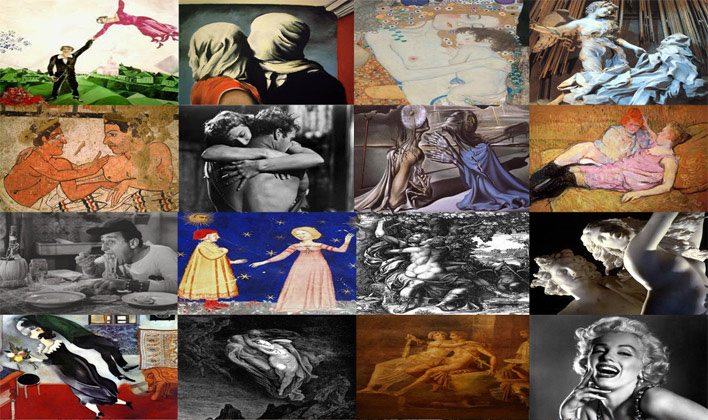Widow, Whore, Saint. Judith as a Figure of Desire (XVIth, XVIIth and XVIIIth Century)
Abstract
The biblical story of Giuditta seductress and then murderess in the name of God was well known. Oloferne, general of Assyrian, surrounded Betulia and the beautiful widow offered herself to save the city. Dressed sumptuously, at night she went outside the city walls to reach the enemy camp and after seducing the unsuspecting general she killed him treacherously in his sleep. The semantic relevance of a figure such as Giuditta is evident, the «vedovetta» (Petrarca, Triumphus Cupidinis, III, v. 53) in fact embodies a particularly complex heroic model. It represents the victory of the weak over the strong (according to the traditional vulgata) and gradually becomes the symbol of strength and female transgression against the male pride that was well represented by Oloferne who overcome by drunkenness and concupiscence met his death by Giuditta’s sword thrusts. Giuditta, being the protagonist of a fabula of great narrative strength, is a perfect figure of desire. Main elements of the story are Love and Death, seduction and castration, female deceit committed through the power of speech and the male weakness for female beauty.
The study evidenced striking similarities between Armida of Tasso, symbol of seduction in the enemy camp and the biblical figure of Giuditta, two “fetishes”, two “objects” of male desire playing the same role (with different issues). Spreading to Europe, in particular the French reformed and catholic production have been taken into account (from Judit by Du Bartas to Holoferne. Tragédie sacrée extraite de l’histoire de Iudith by the priest Adrien d’Amboise). Finally, the relationship between word and image in Iudi, tragedy written by Federico Della Valle was analyzed, wherein the origin of desire (in Oloferne) coincides with the description of a famous female clothing. The purity, the true faith, the uncontaminated virtue of the biblical widow were resumed at the beginning of the 18th century by Metastasio in Betulia Liberata that created a new model of a heroine however without successors. In modern times, in fact, the image of Giuditta is considered as the symbol of female censorship and consequently fated to be mixed up with the myth of Salome also due to some modern Freudian interpretations.
Downloads
References
Borsetto, Luciana, “Trionfante e vittoriosa. Icone di Giuditta nell’epica del Seicento”, Giuditta e altre eroine bibliche tra Rinascimento e Barocco. Orizzonti di senso e di genere, variazioni, riscritture, Padova, Padova University Press, 2011: 75-98.
Brizi, Bruno, “Giuditta e l’oratorio musicale fra Sei e Settecento”, Giuditta e altre eroine bibliche tra Rinascimento e Barocco. Orizzonti di senso e di genere, variazioni, riscritture, Padova, Padova University Press, 2011: 141-165.
Carpané, Lorenzo, Da Giuditta a Giuditta. L’epopea dell’eroina sacra nel Barocco, Alessandria, Edizioni dell’Orso, 2006.
Cosentino, Paola, Le virtù di Giuditta. Il tema biblico della “mulier fortis” nella letteratura del ‘500 e del ‘600, Roma, Aracne, 2012a.
Id., “Sulle orme del Tasso: l’epopea eroica di Giuditta nel ‘600”, Le donne della Bibbia. La Bibbia delle donne, Ed. Rosanna Gorris Camos, Fasano di Brindisi, Schena, 2012b: 371-390.
Cultrera, Gabriella, “Judith et la fatalité: une relecture de l’Holopherne d’Adrien d’Amboise”, Le donne della Bibbia. La Bibbia delle donne, Ed. Rosanna Gorris Camos, Fasano di Brindisi, Schena, 2012: 323-334.
Della Valle, Federico, Opere, Ed. Matteo Durante, Messina, Sicania, 2000-2005.
Dutschke, Denis, “Petrarch’s Triumphal and Cheerful («Allegra») Judith (Triumphus Cupidinis III, 52-57)”, Nuova Rivista di Letteratura Italiana, 1.1 (1998): 35-71.
Ferrer, Véronique, “Judith par Du Bartas: réformes d’un mythe”, Le donne della Bibbia. La Bibbia delle donne. Teatro, letteratura e vita, Ed. Rosanna Gorris Camos, Fasano, Schena, 2012: 287-296
Fiorato, Corinne, “Giuditta e la politica delle ombre. Sulla fruizione politico-letteraria del Librum Iudith nel Rinascimento”, Giuditta e altre eroine bibliche tra Rinascimento e Barocco. Orizzonti di senso e di genere, variazioni, riscritture, Padova, Padova University Press, 2011: 35-61.
Frigo, Daniela, “Dal caos all’ordine: sulla questione del «prender moglie» nella trattatistica del sedicesimo secolo”, Nel cerchio della luna. Figure di donna in alcuni testi del XVI secolo, Ed. M. Zancan, Venezia, Marsilio, 1983: 57-94.
Mangini, Giorgio, “I trionfi di Giuditta. Mutazioni librettistiche della vicenda biblica, prima, durante e dopo l’epoca di Metastasio”, P. Metastasio-W. A. Mozart, La Betulia liberata, Ed. Paolo Pinamonti, (Festival Mozart nel Veneto, Padova 27–30 settembre 1989), Padova, Mediagraf, 1989: 41-81.
Passi, Giuseppe, I donneschi difetti, Venetia, Vincenzo Somascho, 1618, (edizione conservata alla Biblioteca Nazionale di Roma, segnata 14. 11. K. 19).
Petrarca, Francesco, Trionfi, Rime estravaganti, Codice degli Abbozzi, Eds. Vinicio Pacca - Laura Paolino, Milano, Mondadori, 1996.
Refini, Eugenio, “Giuditta, Armida e l’impalpabile velo della seduzione”, Italian Studies, 68.1, (2013): 78-98.
Tasso, Torquato, La Gerusalemme Liberata, Ed. di Franco Tomasi, Milano, Bur, 2009.
Copyright Notice
You are free to copy, distribute and transmit the work, and to adapt the work. You must attribute the work in the manner specified by the author or licensor (but not in any way that suggests that they endorse you or your use of the work).









